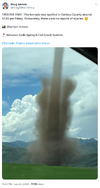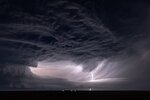You are using an out of date browser. It may not display this or other websites correctly.
You should upgrade or use an alternative browser.
You should upgrade or use an alternative browser.
Crazy Storm Weather and Lightning - Global
- Thread starter mabar
- Start date
Heavy rains caused flooding and washed away vehicles in Tuxtla Gutiérrez
In Tuxtla Gutiérrez, Chiapas, a storm caused flooding and the dragging of several vehicles in the eastern area of the city. Civil Protection authorities reported that these incidents were caused by the recklessness of drivers after attempting to cross streets where rivers were generated.
During the storm, passengers of a public transportation unit were forced to climb on the roof of a nearby house to take shelter and avoid being swept away by the current.
The rain in Tuxtla Gutiérrez lasted approximately one hour and 20 minutes, causing flooding and damage to important roads in the city. Although the intensity of the rain has diminished, authorities continue to make rounds and provide assistance to people who were stranded. It is reported that numerous vehicles were stranded in different parts of the city.

 ahoratabasco.com
ahoratabasco.com
After torrential rains in Chiapas one man died and another disappeared in uncovered sewer
Ariel Muñoz, a 48-year-old biologist and father of two children, wanted to help a person whose truck was stuck in front of his house but never imagined that he would be sucked in by the current of the heavy rain.
Together with seven other people and during the maneuver, he walked with the current on the avenue, but when pushing the truck he suddenly disappeared, he was pulled by the strong current along with two other people, but the latter could be rescued.
In Tuxtla Gutiérrez, Chiapas, a storm caused flooding and the dragging of several vehicles in the eastern area of the city. Civil Protection authorities reported that these incidents were caused by the recklessness of drivers after attempting to cross streets where rivers were generated.
During the storm, passengers of a public transportation unit were forced to climb on the roof of a nearby house to take shelter and avoid being swept away by the current.
The rain in Tuxtla Gutiérrez lasted approximately one hour and 20 minutes, causing flooding and damage to important roads in the city. Although the intensity of the rain has diminished, authorities continue to make rounds and provide assistance to people who were stranded. It is reported that numerous vehicles were stranded in different parts of the city.

Intensas lluvias provocaron inundaciones y arrastre de vehículos en Tuxtla Gutiérrez
En Tuxtla Gutiérrez, Chiapas, una tormenta provocó inundaciones y el arrastre de varios vehículos en la zona oriente de la ciudad.
After torrential rains in Chiapas one man died and another disappeared in uncovered sewer
Ariel Muñoz, a 48-year-old biologist and father of two children, wanted to help a person whose truck was stuck in front of his house but never imagined that he would be sucked in by the current of the heavy rain.
Together with seven other people and during the maneuver, he walked with the current on the avenue, but when pushing the truck he suddenly disappeared, he was pulled by the strong current along with two other people, but the latter could be rescued.
Rare cloud top flashes known as 'pixies' captured up close on a flight in Oklahoma 6/17/2023.
Jun 19, 2023
Jun 19, 2023
This is one of my favorite captures of late. A fascinating and rarely captured cloud top Transient Luminous Event known as a Pixie. Very quick electric blue flashes believed to be 100m or so across. Little research has been done on their formation, but I talked to Jozsef Bohr, a renowned atmospheric scientist, who said they are likely discharges caused by the oppositely charged cloud top being forced through a screening layer in the atmosphere. Some more prominent flashes can be seen that seem to have a nub of a lightning channel, these are either Gnomes or Blue Starters. Rarely seen and captured because of their location on top of the storm. I have only captured several instances from hundreds of hours observing storms- this unique perspective is something I have dreamed of. So interesting to see where they are focused and to see them dancing so fast at times, then to turn completely off. Just wild nature.Could they also be related to hail or other moisture up there? Do they signify another possible mode in storm development? Lots of questions. I would love to hear some input.Contact smith.paul.michael1@gmail.com for licensing
Attachments
#gewitter from yesterday evening in #märkischesviertel #berlin #blitz #donner #regen
It was last May 25 in New Mexico, this incredible #structure #stroboscopique faced us, almost standing still, leaving us plenty of time to observe it in the large #plaines of the city of #Clovis .#nmwx

Prévisions météo des 10 prochains jours
Découvrez nos dernières prévisions météo pour les 10 jours à venir.
Attachments
Golfer killed by a lightning strike during Monday storm
There was a long-duration thunderclap that roared through the valley last night that lasted a good 4 to 6 seconds.

Watch: Video footage captures lightning strikes before thunderous explosion
One local resident described the sound as 'an incredible thunderclap'.
Residents in a West Auckland suburb have woken up to what has been described as a “huge explosion” in the area after a short and sharp weather event in the early hours of this morning.
Northern fire communications confirmed they were called to reports of an explosion during a sudden electrical storm in and around the suburb of Blockhouse Bay about 4.40am.
I am beginning to wonder if some of these thunderclaps are indeed high-altitude meteor bursts.
EVERYTHING THAT GLITTER IS NOT BOLID! Yesterday June 26 a series of storms with giant lightning converged between Albacete, Murcia and Valencia. Let's look at the impressive flash produced by lightning at the Barx-La Drova station operated by Jordi Donet @DonetJorge 1h25m09s TU
EVERYTHING THAT GLITTER IS NOT BOLID! Yesterday June 26 a series of storms with giant lightning converged between Albacete, Murcia and Valencia. Let's look at the impressive flash produced by lightning at the Barx-La Drova station operated by Jordi Donet @DonetJorge 1h25m09s TU
ESA launches its lighting imager Meteosat Third Generation!
03/07/2023 Video Run Time 4:50 min
Thunderstorms turned day into night in the governorate of #الطوال area #جازان this afternoon #الاحد 2-7-2023Jazan-Ksa
03/07/2023 Video Run Time 4:50 min
The Lightning Imager can continuously detect rapid flashes of lighting in Earth’s atmosphere whether day or night from a distance of 36 000 km.
This is the first time a geostationary weather satellite has the capability to detect lightning across Europe, Africa and the surrounding waters. Each camera can capture up to 1000 images per second and will continuously observe lightning activity from space. The data will give weather forecasters greater confidence in their predictions of severe storms.
Thunderstorms turned day into night in the governorate of #الطوال area #جازان this afternoon #الاحد 2-7-2023Jazan-Ksa
Palafrugell, Spain
A friend, Rabida Gomez, from Bisbal d'Empordà, sent me this video right at the time of the storm...
@TomasMolinaB @alexmegapc @ElTiempo_tv @meteo_garraf @meteocat@meteopolita @MeteoElpito@P4Estacions @SeguimlaMeteo
Heavy stormy rain hits Paris this Tuesday evening! They sweep the Ile-de-France, Normandy and Hauts-de-France. ( © Andre Torrent)
Which #régions concerned by the rain-storm degradation? The regions north of the Loire will be the most affected by #précipitations https://tameteo.com/cartes-meteoro
Tomorrow Wednesday, the #tempêtePoly should touch the #PaysBas with gusts which could reach 100 to 140 km/h, according to the models! A rare depression in July and linked to a strong jet stream. (via
@wxcharts)
The arrival of the active cold front is visible on #Bretagne . This front will cross the Paris region tonight and will then progress towards the northeast. As it passes, a gale and moderate rain are expected. #orages are developing at the front in the Pyrenees, between Brittany and Normandy, in the Limousin and in the east of the country.
A friend, Rabida Gomez, from Bisbal d'Empordà, sent me this video right at the time of the storm...
@TomasMolinaB @alexmegapc @ElTiempo_tv @meteo_garraf @meteocat@meteopolita @MeteoElpito@P4Estacions @SeguimlaMeteo
Heavy stormy rain hits Paris this Tuesday evening! They sweep the Ile-de-France, Normandy and Hauts-de-France. ( © Andre Torrent)
Which #régions concerned by the rain-storm degradation? The regions north of the Loire will be the most affected by #précipitations https://tameteo.com/cartes-meteoro
Tomorrow Wednesday, the #tempêtePoly should touch the #PaysBas with gusts which could reach 100 to 140 km/h, according to the models! A rare depression in July and linked to a strong jet stream. (via
@wxcharts)
The arrival of the active cold front is visible on #Bretagne . This front will cross the Paris region tonight and will then progress towards the northeast. As it passes, a gale and moderate rain are expected. #orages are developing at the front in the Pyrenees, between Brittany and Normandy, in the Limousin and in the east of the country.
We had another severe thunderstorm yesterday, and here is a time lapse of the moment the lightning flashed, captured by a wide angle camera pointed east from my home in Hiratsuka on July 4, 2023, between 19:37 and 20:08. You can see the cumulonimbus clouds developing. Translated with Deepl
Last edited by a moderator:
Zaragoza. Spain.
Logroño, España
Tremendous images that come from ZaragozaVia: Guasap#tormentas #zaragoza #granizo #fma
The supercell that has grown in the Iberian System, has crossed Campo de Belchite and is now in Bajo Aragón, has left giant hail in Herrera de los Navarros. Possibly +10 cm.https://heraldo.es/multimedia/imagenes/aragon/fotos-granizada-en-distintos-puntos-de-aragon/1/@essl_ecss @Djpuc @MateuszTaszarek @pgroenemeijer @SpainStormPred
The #Logroño storm has lasted 25 minutes; that of #Navarrete only 5 minutes but it has left hail of 2 cm or more. Photo courtesy of Javier Iribas
#ULTIMAHORA shocking images arrive of a flood in #Zaragoza capital! There are eatations of more than 100 liters. A few minutes ago the city has been affected by a powerful supercell.
#ULTIMAHORA After the images that have come to us from #Zaragoza of a flood, now there are images of another supercell in #Vitoria the capital! Leaving a strong hailstorm.
Line-1
Consequences of this...
Line-2
Flipaaa boy the one that is falling in Zaragoza
Attachments
These are some of the impressive images that the powerful storm that unloaded yesterday in Zaragoza and in some towns located to the south of the city left us
In Zaragoza, the biggest downpour has occurred since I can remember. It has not been the Ebro, it has been all the water that has fallen. They have barely reported on the news. I share the videos and information that they have shared on WhatsApp. If you are the author let me know
Today also in Aragón near Zaragoza.
Trending content
-
-
-
-
Thread 'Coronavirus Pandemic: Apocalypse Now! Or exaggerated scare story?'
- wanderingthomas
Replies: 30K




